![]()
![]()
![]()
Use LEFT and RIGHT arrow keys to navigate between flashcards;
Use UP and DOWN arrow keys to flip the card;
H to show hint;
A reads text to speech;
28 Cards in this Set
- Front
- Back
|
Nucleus (darker areas surrounding paleness)
Euchromatin (lighter coloured, more active central part of nucleus) Heterochromatin (darker coloured, less active on the periphery of the nucleus) Cytoplasm (space between the nucleus and the plasma membrane) Plasma membrane (encapsulating the whole cell) |
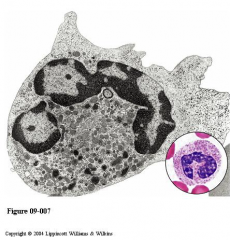
|
|
|
A - Mitochondria surrounded by RER
B - Ribosomes C - Cisternae D - Rough Endoplasmic Reticulum (RER) E - Matrix F - Cristae G - Intermembrane space H - Outer membrare |
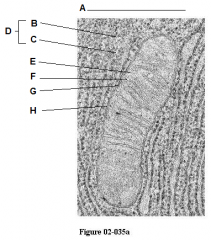
|
|
|
A - Pseudostratified ciliated epithelium of the trachea
B - Basal bodies C - Cilia D - Basement Membrane E - Lamina Propria (CT containing fribroblasts) |
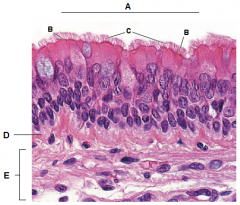
|
|
|
a) Simple columnar epithelium of the small intestine
b)microvilli/brush border c) goblet cell d) lamina propria (loose CT with fibroblasts and lymphocytes present) e) lacteal (lymphatic capillary) |
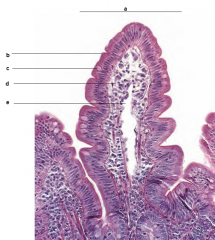
|
|
|
a) Renal corpuscle, kidney (bowmans capsule with JGA)
b) Simple squamous epithelium c) Cuboidal Epithelium |
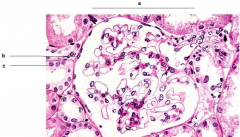
|
|
|
a) Kidney medulla
b) Cuboidal epithelium c) Collecting Tubules, lumen |
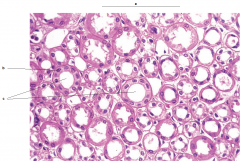
|
|
|
a) Thick skin of the foot (stratified squamous epithelium)
b) Epidermis c) Dermis d) Papillary layer (greater cellularity) e) Reticular layer (greater amount of collagen) f) Stratum corneum g) Stratum lucidum (only in thick skin) h) Stratum granulosum i) Stratum spinosum j) Stratum basale k) Dermal papillae (projections of the dermis) l) Duct of a sweat gland |
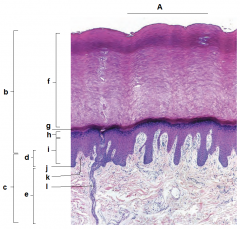
|
|
|
a) Vagina
b) stratified squamous epithelium c) Blood vessels d) Smooth muscle layer |
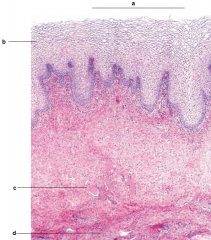
|
|
|
a) Urinary bladder, transitional epithelium
b) Dome cells (in bladder distension, these cells flatten to become squamous) c) Columnar cells? d) Basal cells e) lamina propria (loose CT) |
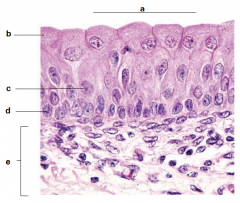
|
|
|
a) Mammary gland showing connective tissue and glands
b) Dense irregular connective tissue (darker staining with fewer nuclei) c) Loose connective tissue (lighter stain, wispy with more nuclei) |
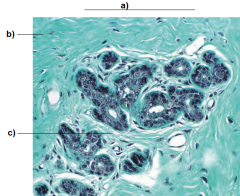
|
|
|
a) Connective Tissue
b) Dense irregular connective tissue c) Loose connective tissue d) Adipocytes |
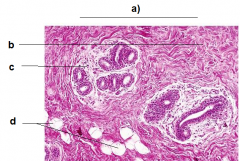
|
|
|
a) Skeletal muscle
b) Muscle fibre c) Nerve bundle d) Nuclei (multiple per cell, at periphery) |

|
|
|
a) Skeletal Muscle from the tongue
b) Muscle fibre/cell (surrounded by endomysium) c)Bundle/fascicle of muscle fibres d)Connective tissue (perimysium) |
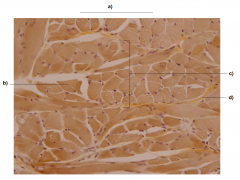
|
|
|
a) Cardiac muscle
b) Cardiac muscle fibre (composed of numerous cardiomyocytes stacked on to one another, can be branched) c) Cardiomyocyte (cylindrical cell with one or two centrally located nuclei) d) Intercalated discs (attachment between cardiomyocytes that binds the cells and allows communication) |
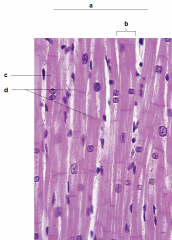
Label and Describe
|
|
|
a) Small Intestine (duodenum)
b) Brunner's glands c) Muscularis mucosae d) Muscularis externis (smooth muscle) e) Longitudinal layer of smooth muscle f) Circular layer of smooth muscle g) Sub mucosa h) Serosa i) Villi j) Mucosa |
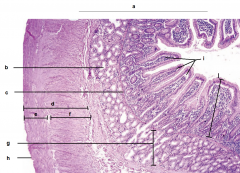
|
|
|
Smooth muscle with transverse and longitudinal fibres
|
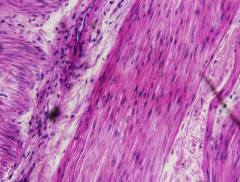
|
|
|
What are the histological features of an elastic artery?
|
Intima - endothelium, CT, smooth muscle cells
Media - Smooth muscle, ELASTIC LAMINA Adventitia - CT, Elastic fibres, thin layer |
|
|
What are the histological features of a muscular artery?
|
Intima - Endothelium, CT, Smooth muscle cells, INTERNAL ELASTIC MEMBRANE
Media - Smooth muscles, Collagen fibres, few elastic fibres Adventitia - CT, few elastic fibres, thin layer |
|
|
What are the histological features of a large vein?
|
Intima - Endothelium, CT, smooth muscle cells
Media - SMOOTH MUSCLE 2-15 LAYERS, collagen fibres Adventitia - thick layer, CT, few elastic fibres, LONGITUDINAL SMOOTH MUSCLE |
|
|
What are the histological features of a medium vein?
|
Intima - endothelium, CT, Smooth muscle cells, +/- INTERNAL ELASTIC MEMBRANE
Media - smooth muscle, collagen fibres Adventitia - CT, few elastic fibres |
|
|
What are the histological features that differentiate an arteriole from a venule?
|
Arterioles contain endothelium, smooth muscle and CT in their intima, whereas venule only have endothelium ony (maybe pericytes). Arterioles have a media with 1-2 layers of smooth muscle, whereas venules can have no media. Arterioles have a very thin sheath of connective tissue as their adventitia, whereas venules have none or a layer thicker than their media.
|
|
|
A) Muscular artery (medium artery)
b) endothelium c) tunica intima (endothelium with loose CT, smooth muscle cells and internal elastic membrane) d) internal elastic membrane (of intima) e) tunica media (collagen, smooth muscle fibres, few elastic fibres) f) tunica adventitia (thin layer) |
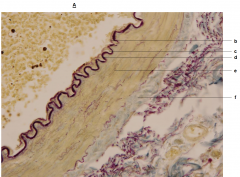
|
|
|
A) Elastic Artery (large artery)
b) Endothelium c)Tunica Intima (no internal elastic membrane) d) Tunica Media (contains elastic lamellae) d) Tunica Adventitia |
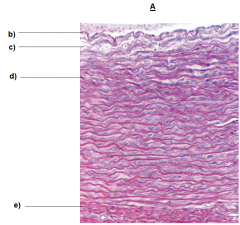
|
|
|
A) Arteriole and venule in the dermis
b) arteriole, cross section c) venule d) arteriole, longitudinal section |
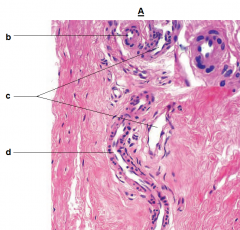
|
|
|
a) arteriole
b) venule |
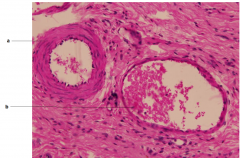
|
|
|
a) Thin skin
b) Epidermis c) dermis |
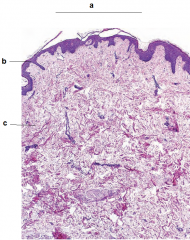
|
|
|
A) Compact bone, long bone
b) periosteum c) osteocyte d) osteoclast |
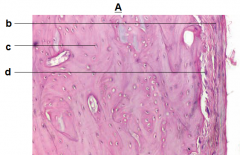
|
|
|
A) Epiphyseal plate
b) Resting cartilage c) proliferating cartilage d) calcified cartilage e) bone |
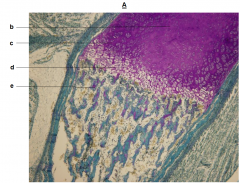
|

